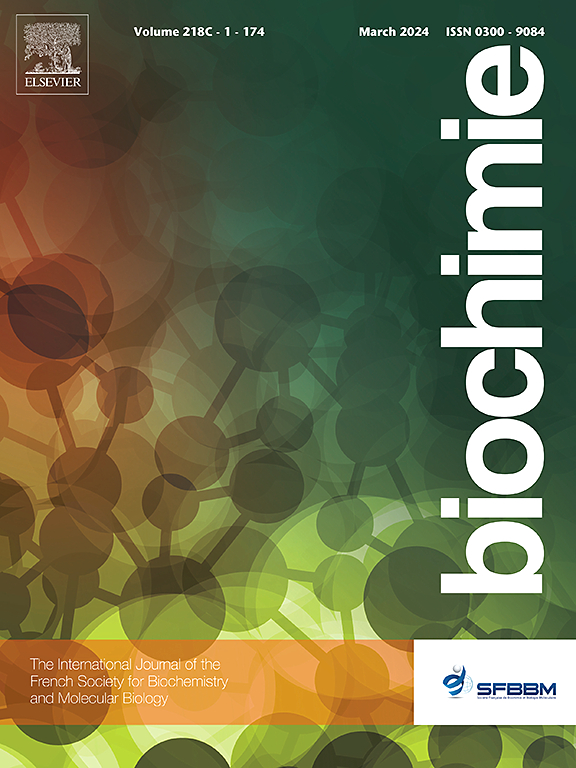在 pH 值为 7.5 的大肠杆菌中,葡萄糖浓度对氢化酶 1 和氢化酶 2 调节质子和钾通量的功能起着决定性作用。
IF 3.3
3区 生物学
Q2 BIOCHEMISTRY & MOLECULAR BIOLOGY
引用次数: 0
摘要
本研究探讨了大肠杆菌在不同葡萄糖浓度(2 g L-1 和 8 g L-1)的发酵过程中,FOF1-ATP酶、氢化酶(Hyd-1 和 Hyd-2)和钾转运系统(TrkA)是如何相互作用以维持质子动力(pmf)的。我们的研究结果表明,与野生型相比,缺乏 hyaA-hyaC 基因的突变体在 2 g L-1 葡萄糖条件下的总质子通量增加了 30%。在补充类似葡萄糖水平的试验中也观察到了这种情况。质子泵的破坏,尤其是 hyaB 和 hyaC 单突变体,导致钾吸收增加。hyaB 突变体中 FOF1-ATP 酶对质子通量的贡献增加了三倍,这表明 Hyd-1 在质子转运中发挥了重要作用。在 2 g L-1 葡萄糖条件下生长的 hybC 突变体中,对 DCCD 敏感的通量减少了 70%,这表明 Hyd-2 在质子转运和 FOF1 功能中起着关键作用。当细胞在 8 g L-1 葡萄糖条件下生长时,野生型和突变体的 2H+/1K+ 比率都受到了显著干扰。尽管存在这些干扰,Hyd-1 和 Hyd-2 中断的突变体仍能保持恒定的 FOF1 功能,这表明该酶在富含葡萄糖的环境中保持稳定。这些结果为了解 Hyd-1 和 Hyd-2 如何对离子转运(尤其是质子转运)的调控做出贡献提供了有价值的见解。我们的研究发现了Hyd-1和Hyd-2亚基之间潜在的互补机制,这表明这些酶之间存在复杂的相互作用,它们通过与FOF1的代谢交叉反应来应对葡萄糖浓度,以维持pmf。本文章由计算机程序翻译,如有差异,请以英文原文为准。

Glucose concentration is determinant for the functioning of hydrogenase 1 and hydrogenase 2 in regulating the proton and potassium fluxes in Escherichia coli at pH 7.5
This study examines how FOF1-ATPase, hydrogenases (Hyd-1 and Hyd-2), and potassium transport systems (TrkA) interact to maintain the proton motive force (pmf) in E. coli during fermentation of different glucose concentrations (2 g L−1 and 8 g L−1). Our findings indicate that mutants lacking the hyaA-hyaC genes exhibited a 30 % increase in total proton flux compared to the wild type when grown with 2 g L−1 glucose. This has been observed during assays where similar glucose levels were supplemented. Disruptions in proton pumping, particularly in hyaB and hyaC single mutants, led to increased potassium uptake. The hyaB mutant showed a threefold increase in the contribution of FOF1-ATPase to proton flux, suggesting a significant role for Hyd-1 in proton translocation. In the hybC mutant grown in 2 g L−1 glucose conditions, DCCD-sensitive fluxes decreased by 70 %, indicating critical role of Hyd-2 in proton transport and FOF1 function. When cells were grown with 8 g L−1 glucose, the 2H+/1K+ ratio was significantly disturbed in both wild type and mutants. Despite these perturbances, mutants with disruptions in Hyd-1 and Hyd-2 maintained constant FOF1 function, suggesting that this enzyme remains stable in glucose-rich environments. These results provide valuable insights into how Hyd-1 and Hyd-2 contribute to the regulation of ion transport, particularly proton translocation, in response to glucose concentration. Our study uncovered potential complementary mechanisms between Hyd-1 and Hyd-2 subunits, suggesting a complex interplay between these enzymes via metabolic cross talk with FOF1 in response to glucose concentrations to maintain pmf.
求助全文
通过发布文献求助,成功后即可免费获取论文全文。
去求助
来源期刊

Biochimie
生物-生化与分子生物学
CiteScore
7.20
自引率
2.60%
发文量
219
审稿时长
40 days
期刊介绍:
Biochimie publishes original research articles, short communications, review articles, graphical reviews, mini-reviews, and hypotheses in the broad areas of biology, including biochemistry, enzymology, molecular and cell biology, metabolic regulation, genetics, immunology, microbiology, structural biology, genomics, proteomics, and molecular mechanisms of disease. Biochimie publishes exclusively in English.
Articles are subject to peer review, and must satisfy the requirements of originality, high scientific integrity and general interest to a broad range of readers. Submissions that are judged to be of sound scientific and technical quality but do not fully satisfy the requirements for publication in Biochimie may benefit from a transfer service to a more suitable journal within the same subject area.
 求助内容:
求助内容: 应助结果提醒方式:
应助结果提醒方式:


